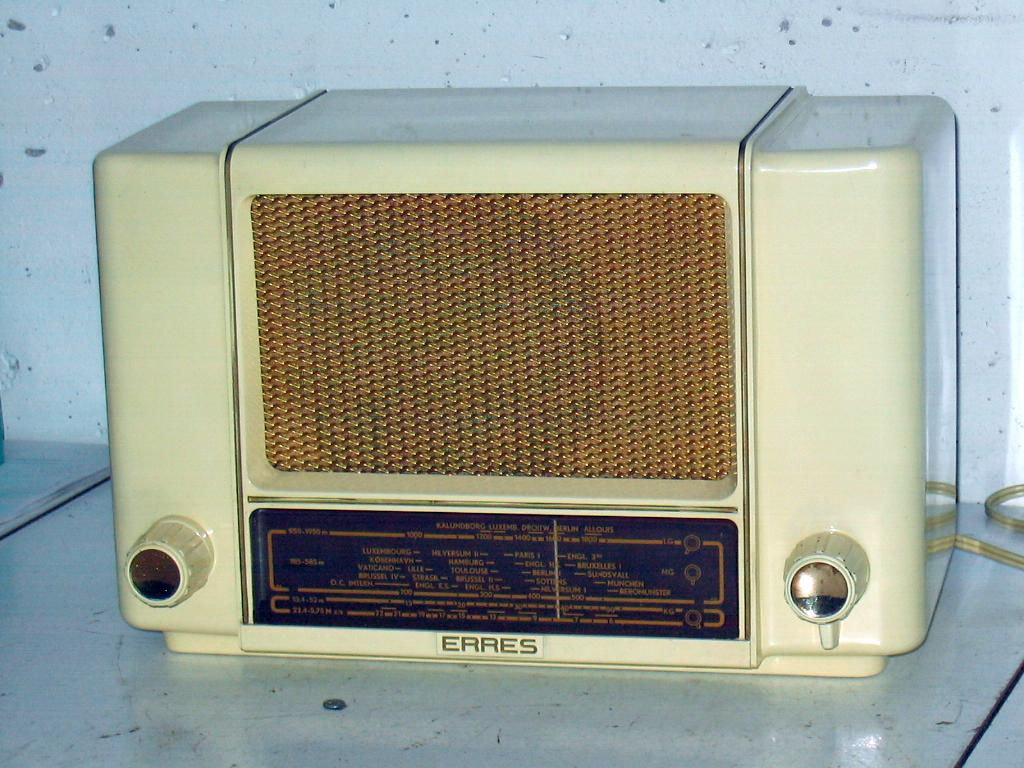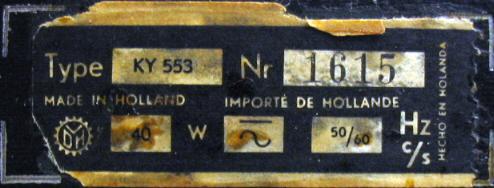Price was fl 155.

Full and original Service Docs, including schema.

287
Item nr.

Ivory with brass.
| Production | The Netherlands, 1955.
Price was fl 155. |
|---|---|
| Bands | LG (950-1950m), MG (185-585m), KG (13.4-52m or 22.4-5.75Mc/s); IF is 453kHz. |
| Tubes | UCH81, UF41, UBC41, UL41, UY41; IF is 452kHz. |
| Cabinet | Bakelite. Size 30x19x14 cm. Weight 3 kg. |
| Power | ACDC, 127/220V, 43W. |
| Documents |  Full and original Service Docs, including schema. |
 Erres radios have the model year as the first two digits of the type number, which easily dates this nice little radio to 1955. Tropicalised variations of Erres radios get an extra digit in the type number. The Erres KY5531 and KY5532 are tropicalised radios in the same cabinet and with the same tubes. The KY5531 has Short and Medium Waves, and a Tropical Band running from 40 to 140 meters of wave length. The KY5532 Short, Tropical, and Long Wave bands, but no Medium Waves! The Service Documentation does not mention in what exotic country such a radio could be sensibly used.
Erres radios have the model year as the first two digits of the type number, which easily dates this nice little radio to 1955. Tropicalised variations of Erres radios get an extra digit in the type number. The Erres KY5531 and KY5532 are tropicalised radios in the same cabinet and with the same tubes. The KY5531 has Short and Medium Waves, and a Tropical Band running from 40 to 140 meters of wave length. The KY5532 Short, Tropical, and Long Wave bands, but no Medium Waves! The Service Documentation does not mention in what exotic country such a radio could be sensibly used.  For symmetry and compactness of design, the band switch is a very little crutch under the tuning knob, just as with the Philips BX200U. Inside you can see that the wave switch is not located under the tuning axis, but the movement is passed through by a little lever.
For symmetry and compactness of design, the band switch is a very little crutch under the tuning knob, just as with the Philips BX200U. Inside you can see that the wave switch is not located under the tuning axis, but the movement is passed through by a little lever.
The little Erres technically resembles the Philips BX200U a lot, but is a little bit more advanced. The most noticeable difference is the introduction of a ferrite antenna, further the mixer tube is the newer UCH81.
| Obtained | 12/2006 from 't Schuurtje (The Little Barn), Driebergen. |
|---|---|
| Condition | 8; complete and working, small scratches, light hum. |
| Value (est.) | 22€. |
| Sound sample | PLAY SOUND I have sufficient parts usually, for this radio as well as for others. Shapewise, my elco's could be called male… But does that make me a man? (Song from Belgian Radio 2, recorded 21/01/2007.) |
 Van der Heem always gave good attention to the isolation of ACDC sets, and in this model, the knob screws were sealed with some kind of wax, which was still present in the tuning knob (photo left).
Van der Heem always gave good attention to the isolation of ACDC sets, and in this model, the knob screws were sealed with some kind of wax, which was still present in the tuning knob (photo left). 
 Unfortunately I could not repair the set safely without pulling the chassis, so I removed the wax. Repair was a routine job: replacement of eight paper-wax capacitors, and the addition of a 47uF capacitor to help the old smoothing cap. Observe the positioning of the smoothing cap under the chassis, where the allowed height is limited. None of my stocked caps could replace the old one. I also replaced the output tube to improve the sound. The radio came complete with back.
Unfortunately I could not repair the set safely without pulling the chassis, so I removed the wax. Repair was a routine job: replacement of eight paper-wax capacitors, and the addition of a 47uF capacitor to help the old smoothing cap. Observe the positioning of the smoothing cap under the chassis, where the allowed height is limited. None of my stocked caps could replace the old one. I also replaced the output tube to improve the sound. The radio came complete with back.